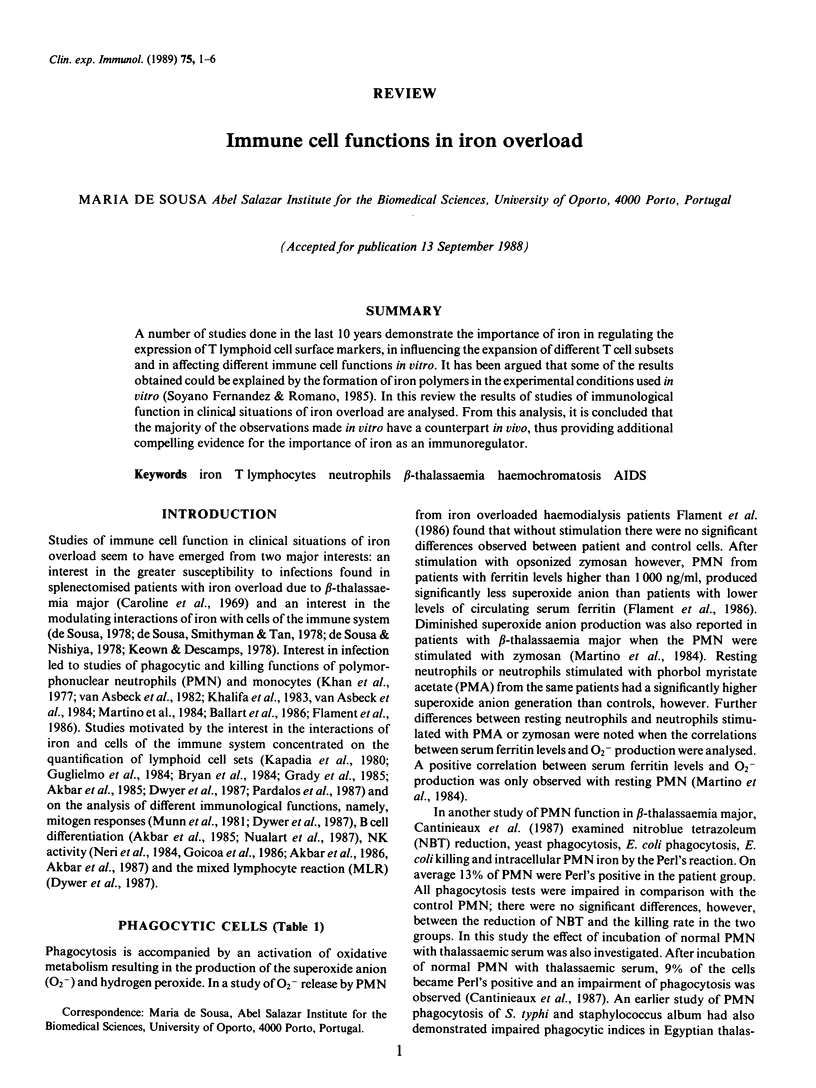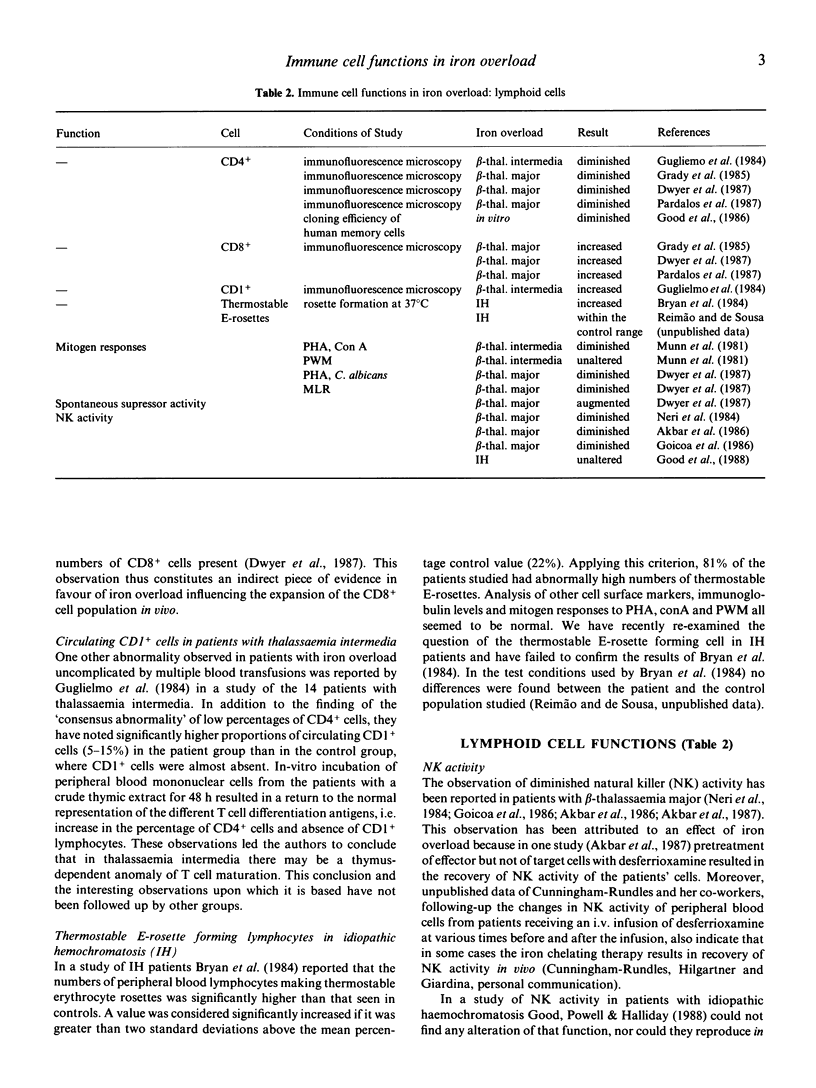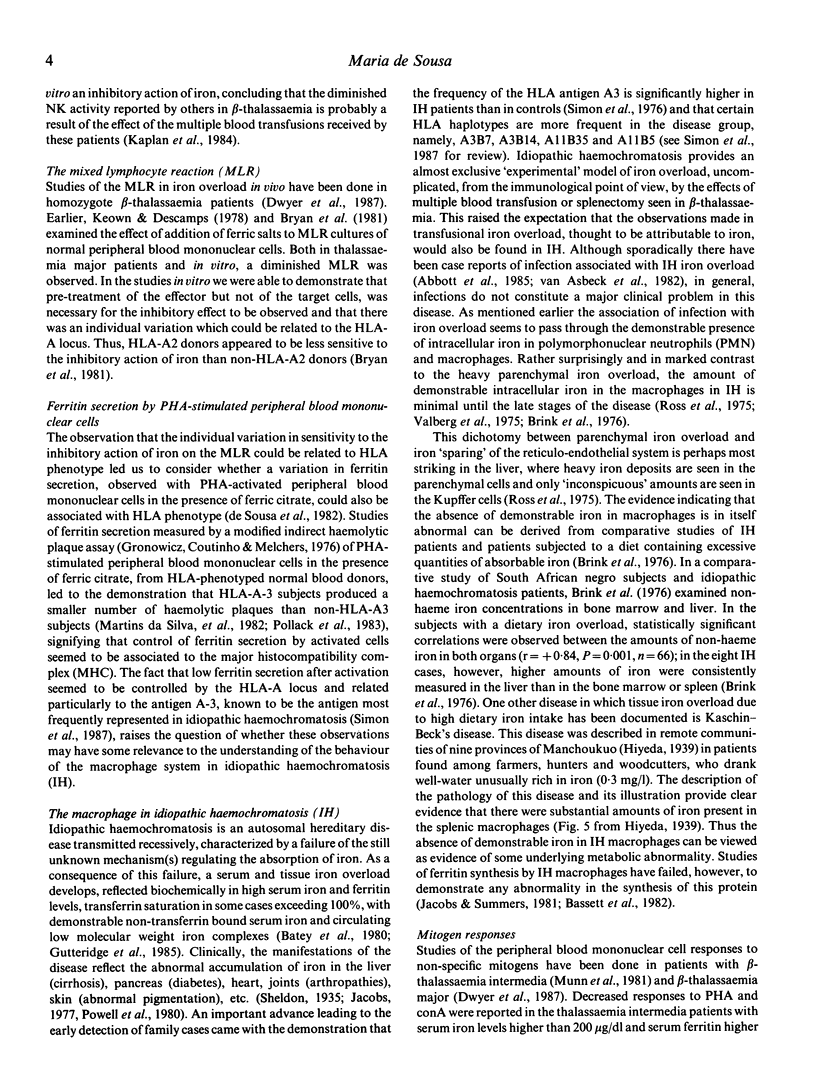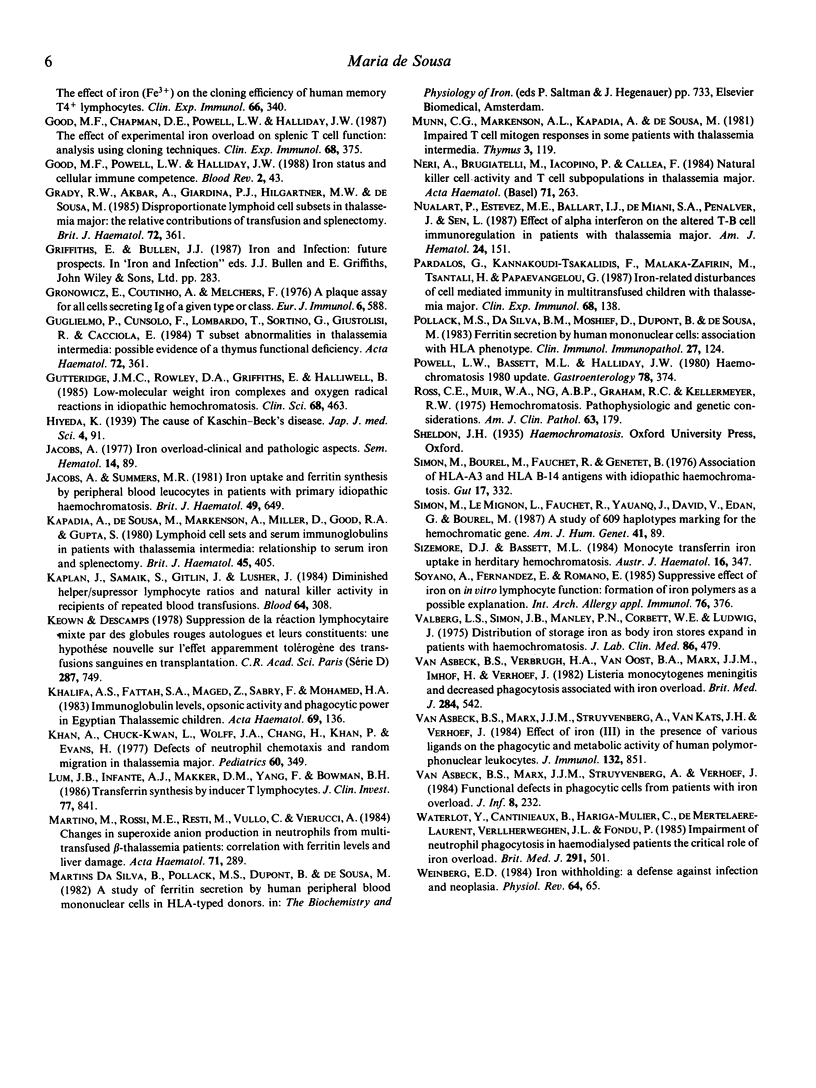Abstract
A number of studies done in the last 10 years demonstrate the importance of iron in regulating the expression of T lymphoid cell surface markers, in influencing the expansion of different T cell subsets and in affecting different immune cell functions in vitro. It has been argued that some of the results obtained could be explained by the formation of iron polymers in the experimental conditions used in vitro (Soyano Fernandez & Romano, 1985). In this review the results of studies of immunological function in clinical situations of iron overload are analysed. From this analysis, it is concluded that the majority of the observations made in vitro have a counterpart in vivo, thus providing additional compelling evidence for the importance of iron as an immunoregulator.
Full text
PDF





Selected References
These references are in PubMed. This may not be the complete list of references from this article.
- Abbott M., Galloway A., Cunningham J. L. Haemochromatosis presenting with a double Yersinia infection. J Infect. 1986 Sep;13(2):143–145. doi: 10.1016/s0163-4453(86)92869-0. [DOI] [PubMed] [Google Scholar]
- Akbar A. N., Fitzgerald-Bocarsly P. A., Giardina P. J., Hilgartner M. W., Grady R. W. Modulation of the defective natural killer activity seen in thalassaemia major with desferrioxamine and alpha-interferon. Clin Exp Immunol. 1987 Nov;70(2):345–353. [PMC free article] [PubMed] [Google Scholar]
- Akbar A. N., Fitzgerald-Bocarsly P. A., de Sousa M., Giardina P. J., Hilgartner M. W., Grady R. W. Decreased natural killer activity in thalassemia major: a possible consequence of iron overload. J Immunol. 1986 Mar 1;136(5):1635–1640. [PubMed] [Google Scholar]
- Akbar A. N., Giardina P. J., Hilgartner M. W., Grady R. W. Immunological abnormalities in thalassaemia major. I. A transfusion-related increase in circulating cytoplasmic immunoglobulin-positive cells. Clin Exp Immunol. 1985 Nov;62(2):397–404. [PMC free article] [PubMed] [Google Scholar]
- Ballart I. J., Estevez M. E., Sen L., Diez R. A., Giuntoli J., de Miani S. A., Peñalver J. Progressive dysfunction of monocytes associated with iron overload and age in patients with thalassemia major. Blood. 1986 Jan;67(1):105–109. [PubMed] [Google Scholar]
- Bassett M. L., Halliday J. W., Powell L. W. Ferritin synthesis in peripheral blood monocytes in idiopathic hemochromatosis. J Lab Clin Med. 1982 Jul;100(1):137–145. [PubMed] [Google Scholar]
- Batey R. G., Lai Chung Fong P., Shamir S., Sherlock S. A non-transferrin-bound serum iron in idiopathic hemochromatosis. Dig Dis Sci. 1980 May;25(5):340–346. doi: 10.1007/BF01308057. [DOI] [PubMed] [Google Scholar]
- Björn-Rasmussen E., Hageman J., van den Dungen P., Prowit-Ksiazek A., Biberfeld P. Transferrin receptors on circulating monocytes in hereditary haemochromatosis. Scand J Haematol. 1985 Apr;34(4):308–311. doi: 10.1111/j.1600-0609.1985.tb00753.x. [DOI] [PubMed] [Google Scholar]
- Brink B., Disler P., Lynch S., Jacobs P., Charlton R., Bothwell T. Patterns of iron storage in dietary iron overload and idiopathic hemochromatosis. J Lab Clin Med. 1976 Nov;88(5):725–731. [PubMed] [Google Scholar]
- Bryan C. F., Leech S. H., Bozelka B. The immunoregulatory nature of iron. II. Lymphocyte surface marker expression. J Leukoc Biol. 1986 Nov;40(5):589–600. doi: 10.1002/jlb.40.5.589. [DOI] [PubMed] [Google Scholar]
- Bryan C. F., Leech S. H., Ducos R., Edwards C. Q., Kushner J. P., Skolnick M. H., Bozelka B., Linn J. C., Gaumer R. Thermostable erythrocyte rosette-forming lymphocytes in hereditary hemochromatosis. I. Identification in peripheral blood. J Clin Immunol. 1984 Mar;4(2):134–142. doi: 10.1007/BF00915047. [DOI] [PubMed] [Google Scholar]
- Bryan C. F., Nishiya K., Pollack M. S., Dupont B., de Sousa M. Differential inhibition of the MLR by iron: association with HLA phenotype. Immunogenetics. 1981;12(1-2):129–140. doi: 10.1007/BF01561656. [DOI] [PubMed] [Google Scholar]
- Cantinieaux B., Hariga C., Ferster A., De Maertelaere E., Toppet M., Fondu P. Neutrophil dysfunctions in thalassaemia major: the role of cell iron overload. Eur J Haematol. 1987 Jul;39(1):28–34. doi: 10.1111/j.1600-0609.1987.tb00159.x. [DOI] [PubMed] [Google Scholar]
- Caroline L., Kozinn P. J., Feldman F., Stiefel F. H., Lichtman H. Infection and iron overload in thalassemia. Ann N Y Acad Sci. 1969 Nov 20;165(1):148–155. doi: 10.1111/j.1749-6632.1969.tb27784.x. [DOI] [PubMed] [Google Scholar]
- De Sousa M. Lymphoid cell positioning: a new proposal for the mechanism of control of lymphoid cell migration. Symp Soc Exp Biol. 1978;32:393–410. [PubMed] [Google Scholar]
- De Sousa M., Nishiya K. Inhibition of E-rosette formation by two iron salts. Cell Immunol. 1978 Jun;38(1):203–208. doi: 10.1016/0008-8749(78)90048-5. [DOI] [PubMed] [Google Scholar]
- Dwyer J., Wood C., McNamara J., Williams A., Andiman W., Rink L., O'Connor T., Pearson H. Abnormalities in the immune system of children with beta-thalassaemia major. Clin Exp Immunol. 1987 Jun;68(3):621–629. [PMC free article] [PubMed] [Google Scholar]
- Flament J., Goldman M., Waterlot Y., Dupont E., Wybran J., Vanherweghem J. L. Impairment of phagocyte oxidative metabolism in hemodialyzed patients with iron overload. Clin Nephrol. 1986 May;25(5):227–230. [PubMed] [Google Scholar]
- Good M. F., Chapman D. E., Powell L. W., Halliday J. W. The effect of experimental iron-overload on splenic T cell function: analysis using cloning techniques. Clin Exp Immunol. 1987 May;68(2):375–383. [PMC free article] [PubMed] [Google Scholar]
- Good M. F., Chapman D. E., Powell L. W., Halliday J. W. The effect of iron (Fe3+) on the cloning efficiency of human memory T4+ lymphocytes. Clin Exp Immunol. 1986 Nov;66(2):340–347. [PMC free article] [PubMed] [Google Scholar]
- Good M. F., Powell L. W., Halliday J. W. Iron status and cellular immune competence. Blood Rev. 1988 Mar;2(1):43–49. doi: 10.1016/0268-960x(88)90007-0. [DOI] [PubMed] [Google Scholar]
- Gronowicz E., Coutinho A., Melchers F. A plaque assay for all cells secreting Ig of a given type or class. Eur J Immunol. 1976 Aug;6(8):588–590. doi: 10.1002/eji.1830060812. [DOI] [PubMed] [Google Scholar]
- Guglielmo P., Cunsolo F., Lombardo T., Sortino G., Giustolisi R., Cacciola E., Cacciola E. T-subset abnormalities in thalassaemia intermedia: possible evidence for a thymus functional deficiency. Acta Haematol. 1984;72(6):361–367. doi: 10.1159/000206421. [DOI] [PubMed] [Google Scholar]
- Gutteridge J. M., Rowley D. A., Griffiths E., Halliwell B. Low-molecular-weight iron complexes and oxygen radical reactions in idiopathic haemochromatosis. Clin Sci (Lond) 1985 Apr;68(4):463–467. doi: 10.1042/cs0680463. [DOI] [PubMed] [Google Scholar]
- Jacobs A. Iron overload--clinical and pathologic aspects. Semin Hematol. 1977 Jan;14(1):89–113. [PubMed] [Google Scholar]
- Jacobs A., Summers M. R. Iron uptake and ferritin synthesis by peripheral blood leucocytes in patients with primary idiopathic haemochromatosis. Br J Haematol. 1981 Dec;49(4):649–652. doi: 10.1111/j.1365-2141.1981.tb07276.x. [DOI] [PubMed] [Google Scholar]
- Kapadia A., de Sousa M., Markenson A. L., Miller D. R., Good R. A., Gupta S. Lymphoid cell sets and serum immunoglobulins in patients with thalassaemia intermedia: relationship to serum iron and splenectomy. Br J Haematol. 1980 Jul;45(3):405–416. doi: 10.1111/j.1365-2141.1980.tb07161.x. [DOI] [PubMed] [Google Scholar]
- Kaplan J., Sarnaik S., Gitlin J., Lusher J. Diminished helper/suppressor lymphocyte ratios and natural killer activity in recipients of repeated blood transfusions. Blood. 1984 Jul;64(1):308–310. [PubMed] [Google Scholar]
- Keown P., Descamps B. Suppression de la réaction lymphocytaire mixte par des globules rouges autologues et leurs constituants : une hypothèse nouvelle sur l'effet apparement tolérogène des transfusions sanguines en transplantation. C R Acad Sci Hebd Seances Acad Sci D. 1978 Oct 2;287(7):749–752. [PubMed] [Google Scholar]
- Khalifa A. S., Fattah S. A., Maged Z., Sabry F., Mohamed H. A. Immunoglobulin levels, opsonic activity and phagocytic power in Egyptian thalassemic children. Acta Haematol. 1983;69(2):136–139. doi: 10.1159/000206875. [DOI] [PubMed] [Google Scholar]
- Khan A. J., Lee C. K., Wolff J. A., Chang H., Khan P., Evans H. E. Defects of neutrophil chemotaxis and random migration in thalassemia major. Pediatrics. 1977 Sep;60(3):349–351. [PubMed] [Google Scholar]
- Lum J. B., Infante A. J., Makker D. M., Yang F., Bowman B. H. Transferrin synthesis by inducer T lymphocytes. J Clin Invest. 1986 Mar;77(3):841–849. doi: 10.1172/JCI112381. [DOI] [PMC free article] [PubMed] [Google Scholar]
- Munn C. G., Markenson A. L., Kapadia A., de Sousa M. Impaired T-cell mitogen responses in some patients with thalassemia intermedia. Thymus. 1981 Aug;3(2):119–128. [PubMed] [Google Scholar]
- Neri A., Brugiatelli M., Iacopino P., Callea V., Ronco F. Natural killer cell activity and T subpopulations in thalassemia major. Acta Haematol. 1984;71(4):263–269. doi: 10.1159/000206598. [DOI] [PubMed] [Google Scholar]
- Nualart P., Estevez M. E., Ballart I. J., de Miani S. A., Peñalver J., Sen L. Effect of alpha interferon on the altered T-B-cell immunoregulation in patients with thalassemia major. Am J Hematol. 1987 Feb;24(2):151–159. doi: 10.1002/ajh.2830240206. [DOI] [PubMed] [Google Scholar]
- Pardalos G., Kanakoudi-Tsakalidis F., Malaka-Zafiriu M., Tsantali H., Athanasiou-Metaxa M., Kallinikos G., Papaevangelou G. Iron-related disturbances of cell-mediated immunity in multitransfused children with thalassemia major. Clin Exp Immunol. 1987 Apr;68(1):138–145. [PMC free article] [PubMed] [Google Scholar]
- Pollack M. S., da Silva B. M., Moshief R. D., Groshen S., Bognacki J., Dupont B., de Sousa M. Ferritin secretion by human mononuclear cells: association with HLA phenotype. Clin Immunol Immunopathol. 1983 Apr;27(1):124–134. doi: 10.1016/0090-1229(83)90061-2. [DOI] [PubMed] [Google Scholar]
- Powell L. W., Bassett M. L., Halliday J. W. Hemochromatosis: 1980 update. Gastroenterology. 1980 Feb;78(2):374–381. [PubMed] [Google Scholar]
- Ross C. E., Muir W. A., Alan B. P., Graham R. C., Kellermeyer R. W. Hemochromatosis. Pathophysiologic and genetic considerations. Am J Clin Pathol. 1975 Feb;63(2):179–191. doi: 10.1093/ajcp/63.2.179. [DOI] [PubMed] [Google Scholar]
- Simon M., Bourel M., Fauchet R., Genetet B. Association of HLA-A3 and HLA-B14 antigens with idiopathic haemochromatosis. Gut. 1976 May;17(5):332–334. doi: 10.1136/gut.17.5.332. [DOI] [PMC free article] [PubMed] [Google Scholar]
- Simon M., Le Mignon L., Fauchet R., Yaouanq J., David V., Edan G., Bourel M. A study of 609 HLA haplotypes marking for the hemochromatosis gene: (1) mapping of the gene near the HLA-A locus and characters required to define a heterozygous population and (2) hypothesis concerning the underlying cause of hemochromatosis-HLA association. Am J Hum Genet. 1987 Aug;41(2):89–105. [PMC free article] [PubMed] [Google Scholar]
- Sizemore D. J., Bassett M. L. Monocyte transferrin-iron uptake in hereditary hemochromatosis. Am J Hematol. 1984 May;16(4):347–354. doi: 10.1002/ajh.2830160405. [DOI] [PubMed] [Google Scholar]
- Soyano A., Fernández E., Romano E. Suppressive effect of iron on in vitro lymphocyte function: formation of iron polymers as a possible explanation. Int Arch Allergy Appl Immunol. 1985;76(4):376–378. doi: 10.1159/000233725. [DOI] [PubMed] [Google Scholar]
- Valberg L. S., Simon J. B., Manley P. N., Corbett W. E., Ludwig J. Distribution of storage iron as body stores expand in patients with hemochromatosis. J Lab Clin Med. 1975 Sep;86(3):479–489. [PubMed] [Google Scholar]
- Waterlot Y., Cantinieaux B., Hariga-Muller C., De Maertelaere-Laurent E., Vanherweghem J. L., Fondu P. Impaired phagocytic activity of neutrophils in patients receiving haemodialysis: the critical role of iron overload. Br Med J (Clin Res Ed) 1985 Aug 24;291(6494):501–504. doi: 10.1136/bmj.291.6494.501. [DOI] [PMC free article] [PubMed] [Google Scholar]
- Weinberg E. D. Iron withholding: a defense against infection and neoplasia. Physiol Rev. 1984 Jan;64(1):65–102. doi: 10.1152/physrev.1984.64.1.65. [DOI] [PubMed] [Google Scholar]
- de Martino M., Rossi M. E., Resti M., Vullo C., Vierucci A. Changes in superoxide anion production in neutrophils from multitransfused beta-thalassemia patients: correlation with ferritin levels and liver damage. Acta Haematol. 1984;71(5):289–298. doi: 10.1159/000206604. [DOI] [PubMed] [Google Scholar]
- de Sousa M., Dynesius-Trentham R., Mota-Garcia F., da Silva M. T., Trentham D. E. Activation of rat synovium by iron. Arthritis Rheum. 1988 May;31(5):653–661. doi: 10.1002/art.1780310511. [DOI] [PubMed] [Google Scholar]
- de Sousa M., Smithyman A., Tan C. Suggested models of ecotaxopathy in lymphoreticular malignancy. A role for iron-binding proteins in the control of lymphoid cell migration. Am J Pathol. 1978 Feb;90(2):497–520. [PMC free article] [PubMed] [Google Scholar]
- van Asbeck B. S., Marx J. J., Struyvenberg A., Verhoef J. Functional defects in phagocytic cells from patients with iron overload. J Infect. 1984 May;8(3):232–240. doi: 10.1016/s0163-4453(84)93955-0. [DOI] [PubMed] [Google Scholar]
- van Asbeck B. S., Marx J. J., Struyvenberg A., van Kats J. H., Verhoef J. Effect of iron (III) in the presence of various ligands on the phagocytic and metabolic activity of human polymorphonuclear leukocytes. J Immunol. 1984 Feb;132(2):851–856. [PubMed] [Google Scholar]
- van Asbeck B. S., Verbrugh H. A., van Oost B. A., Marx J. J., Imhof H. W., Verhoef J. Listeria monocytogenes meningitis and decreased phagocytosis associated with iron overload. Br Med J (Clin Res Ed) 1982 Feb 20;284(6315):542–544. doi: 10.1136/bmj.284.6315.542. [DOI] [PMC free article] [PubMed] [Google Scholar]


